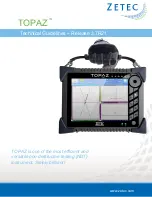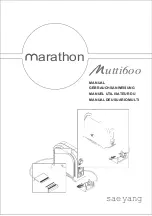
4
4
4
4
4
IT
ALIANO
BATTERIA E CARICA BATTERIA ELETTROZAPPA 12V (FIG.5)
Prima di avviare la macchina, occorre caricare la batteria posizionata sotto il coperchio. Per sbloccarlo esercitare una leggera pressione sul gancio
superiore, quindi scollegare il connettore (1) ed estrarre la batteria. Inserire il connettore della batteria (1) a quello del carica batteria e collegare la
spina a una presa di corrente a 230V. Il LED SPENTO sta ad indicare che la batteria è completamente carica; il ciclo di carica può durare anche 14-
16 ore. A questo punto rimettere la batteria nella sede della macchina, ricollegare i connettori e chiudere il coperchio. Nel caso che le frese ruotino in
senso contrario (la macchina retrocede) significa che sono stati invertiti i collegamenti alle polarità della batteria, quindi occorre provvedere a
riposizionare i connettori posti su di essa.
Quando, durante l’utilizzo, la fresa inizia a ruotare più lentamente e con fatica, significa che la batteria è scarica. Non insistere a lavorare in queste condi-
zioni, perché la batteria si danneggerebbe irrimediabilmente.
Per mantenere la batteria in buone condizioni occorre ricaricarla come descritto in precedenza dopo ogni utilizzo e dopo massimo 4 mesi di
inattività. Ricordarsi inoltre di scollegare il connettore (1) prima di un periodo prolungato di non utilizzo. Una durata di esercizio notevolmente ridot-
ta per ogni carica, indica che la batteria è consumata e va sostituita.
Proteggere la batteria da surriscaldamento e fiamme:
Pericolo di esplosioni!
Non deporre la batteria su radiatori e non esporla per un periodo prolungato all’irradiamento solare; temperature superiori a 50°C la danneggiano.
Prima di caricarla farla raffreddare.
AVVERTENZE PER LA PROTEZIONE DELL'AMBIENTE
Apparecchi, accessori ed imballaggio dovrebbero essere inviati ad una riutilizzazione ecologica. Le batterie esaurite devono essere riciclate secondo
la direttiva 91/157/CEE. Non gettare la batteria consumata tra i rifiuti domestici, nel fuoco o nell’acqua. Non aprire la batteria e restituirla usando le
apposite strutture di raccolta.
Non smaltire insieme ai rifiuti solidi urbani, ma raccogliere separatamente. Le sostanze ed i componenti elettrici contenuti nel presente apparecchio, se
abbandonati od utilizzati in modo improprio, potrebbero rivelarsi dannose per l'ambiente. Il simbolo del "bidone della spazzatura su ruote barrato e con
una barra nera raffigurata sotto il bidone", indica che il presente apparecchio è stato immesso in commercio dopo il 13/08/05 ed è soggetto a raccolta diffe-
renziata. Ogni abuso verrà perseguito a norma di legge.
MARCATURE DI CONTROLLO SICUREZZA
5
5
5
5
5
ENGLISH
7
7
7
7
7
6
6
6
6
6
ENGLISH
List of contents
Introduction
Conditions of use
Safety precautions
Electrical safety
Assembly
Starting
Maintenance
Technical specifications
Noise level
Battery
Safeguarding the
environment
Serious risk for operator
and bystander safety.
INTRODUCTION
Dear Customer,
Thank you for your confidence in purchasing our products. We wish you to enjoy using our
machines.
The following working instructions have been issued to ensure you a reliable running from the beginning.
If you carefully follow such information the machine will operate with complete satisfaction and have a long
service life. Our machines are tested under the most severe conditions before being put into production
and are subjected to strict continuous test during manufacturing stages.
The present unit has been tested in the country of origin by independent testing authorities
in accordance with strict work norms and safety standards.
When required, only original spare parts must be used to maintain guaranteed functions and
safety level.
The operator forfeits any claims which may arise if the machine shows to be fitted with
components other than original spare parts.
Subject to changes in design and construction without notice.
For any questions or further information and spare parts orders, we need to be informed of the unit of the
unit serial number printed on the side of the machine.
IDENTIFICATION DATA (Fig. 1)
The tag plate with the machine data and Serial N° is on the right side of the cultivator under the engine.
Note -
Always state your motor cultivator serial number when you need Technical Service or Spare Parts.
CONDITIONS OF USE AND LIMITATIONS OF USE
The electric steerage hoe is designed for D.I.Y. use. It can break up clods and turn the soil in small and
medium sized gardens and private areas.
It must not, therefore, be used in public areas, parks or sports fields.
The electric steerage hoe must only be used with genuine spare parts and implements. All use differing from
that described is illegal and, besides voiding the warranty, will also lead to serious danger for the operator
and exposed persons.
SAFETY PRECAUTIONS
Attention: Before assembly and putting into operation, please read the operating instruction carefully.
Persons not familiar with these instructions should not use the machine.
1. Young persons under 16 should not be allowed to use the machine.
2. Make sure that there are no children in the vicinity. You are responsible for any damage to third
parties.
ENGLISH
3. Before starting the implement, check the soil and remove any stones, twigs and so forth. Keep checking to make sure that the area is clear
of these as you work.
4. If you encounter an obstruction during work despite all these precautions, turn off the electric steerage hoe and remove the object in
question.
5. Make sure that the implement has not been damaged and have it repaired if necessary.
6. The hoe blades must only be mounted, demounted, cleaned and serviced with the motor off and the plug removed from the power socket
or from the battery.
7. The hoe blades are a danger for the feet when the implement is running. Wear appropriate footwear and keep the feet well away.
8. Do not spray water on to the electric steerage hoe and keep it sheltered from the damp.
9. Remember that the manufacturer declines all responsibility for damage due to: a) repairs made by unskilled persons or unauthorized
service centers; b) use of SPURIOUS SPARE PARTS.
The same conditions apply to the accessories.
ELECTRICAL SAFETY OF THE 230V ELECTRIC STEERAGE HOE
1. The section of the electric power cable must be the same as that of class 05 RN or more.
2. Always make sure that the power cable is not damaged or worn. Immediately remove the plug from the electric power source if it becomes
damaged or is cut during work.
3. The plug on the power cable must be watertight.
4. Always keep the power cable well away from the hoe blades.
5. Before checking the power cable, turn off the implement and remove the plug from the power socket.
6. Only use safe and reliable power cables. Contact a reputable electrician if in doubt.
7. Always remove the plug from the power socket before storing the electric steerage hoe.
ASSEMBLING THE ELECTRIC STEERAGE HOE (FIG.2-4)
Unless different agreements have been reached, the electric steerage hoe is delivered demounted and adequately packed. To assemble the electric
steerage hoe, fit the handle (1) into the body (2) and fasten with the enclosed screws (3). Now add the side handle (4), setting it to the right or left in
the most convenient place, and fixing it to the central handle with the plug (5) and screws (6).
STARTING THE 230 V ELECTRIC STEERAGE HOE (FIG. 3-7)
Fit the Schuko plug into the power cable socket, wrapping the cable around the handle as indicated (fig.7). Now fit the other end of the power cable
into the power socket (230 Volts). Release the safety lock by pressing the side button (1) while pressing the start button (2) at the same time. Release
the start button to turn off the machine and disengage the hoe blades.
STARTING THE 12 V ELECTRIC STEERAGE HOE (FIG. 3)
Bring the battery to its maximum charge and then connect it to the machine (see BATTERY AND BATTERY CHARGER). Release the safety lock by
pressing the side button (1) while pressing the start button (2) at the same time. Release the start button to turn off the machine and disengage the
hoe blades.
The correct position in which to use the electric steerage hoe is illustrated in figure 6. A moderate ground speed will allow you to work the soil more deeply.
Adjust your ground speed by handling the machine as required. There is no need to push the handgrip downwards.
If the hoe blades become blocked by an obstruction when the electric steerage hoe is being used, a clutch will automatically operate to protect the
machine against possible breakage. Turn the steerage hoe off immediately and then pull the machine towards you so that the hoe blades turn in
reverse, thus freeing themselves from the obstruction.
Remember to disconnect the machine from the electric power source if you need to free
the hoe blades by hand.
MAINTENANCE
The electric steerage hoe needs no maintenance. Make sure that the cooling air grilles are always free.
Clean off any soil and mud with a dry cloth or brush. The transmission unit needs no maintenance and must not be opened.
TECHNICAL SPECIFICATIONS
ELETTRIC HOE
Motor voltage rating
Power
Hoe blade width
Hoe blade diameter
RPM rate
Transmission
Weight
Noise level
Vibrations
Battery
Voltage
Capacity
Weight
with battery
12V
250W
160mm
160mm
230
Gears
7,3 Kg.
72 dBA
0,6 m/s
2
12V
7A
2,6 Kg.
230V
230V
250W
160mm
160mm
230
Gears
4,8 Kg.
80 dBA
0,84 m/s
2
-
-
-
-




























